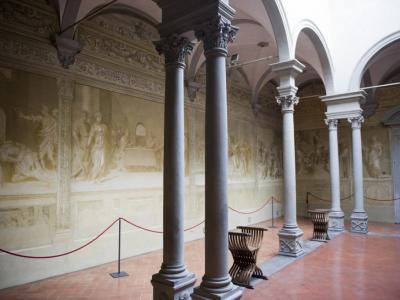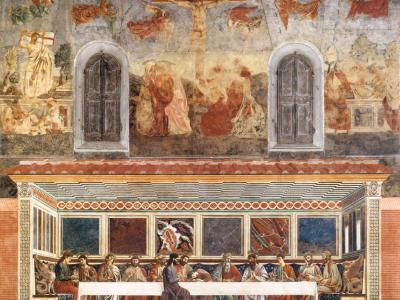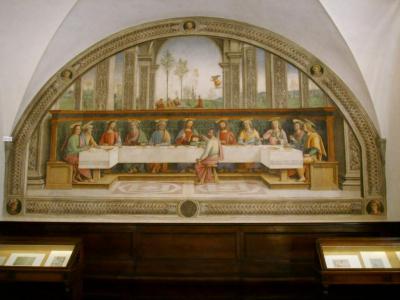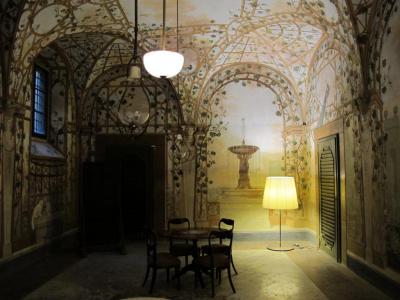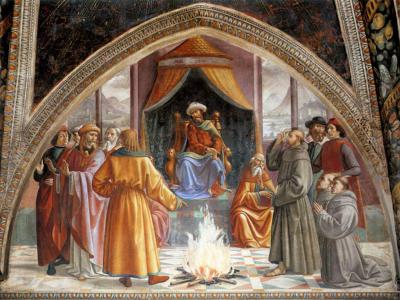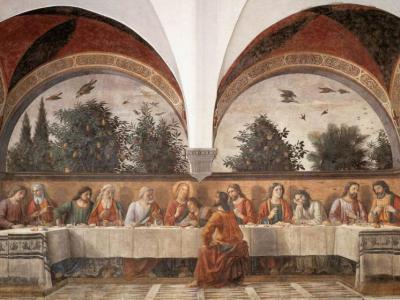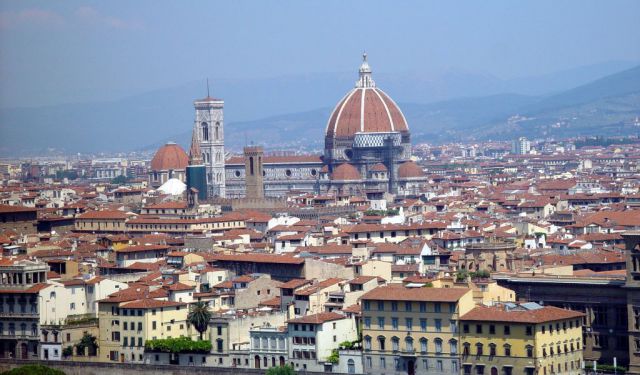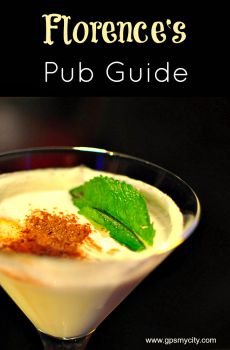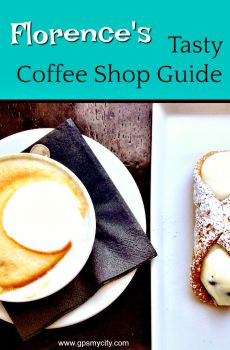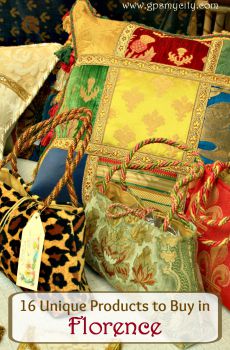Florence's Hidden Art Treasures (Self Guided), Florence
The “Cradle of the Renaissance,” Florence is one of Europe’s most beautiful and busiest destinations, home to some of the world's greatest pieces of art and architecture. The iconic masters like Giotto, Botticelli, Raphael and Michelangelo, as well as their somewhat less-known but equally talented counterparts, such as Ghirlandaio, Sangallo and Castagno, have blessed this city with their creations, leaving behind a wealth of spectacular artistic treasures – chiseled, painted, or erected in stone.
With more than 4 million visitors lured to Florence each year, it’s no surprise that on a repeat trip to the Renaissance capital you may want to avoid this seemingly ever-present tourist siege. Luckily, there's much more in this cultural mecca than meets the eye. In fact, some of the city's most impressive works are tucked away in the off-center locations and thus don’t get that many viewers. What's also important is that much of this beauty can be seen without payment whilst wandering the squares, entering the churches graced by the talent of renowned painters and sculptors, observing the adornments on buildings and opting for free museums.
Rounded up here are some off-the-beaten-path locations in Florence where you can admire a groundbreaking painting, sculpture, or fresco without having to endure long lines and perpetual crowds:
Chiostro della Scalzo – one of Florence’s most intimate and beautiful spaces, featuring a combination of Sangallo’s architecture and Andrea del Sarto’s frescoes;
The Last Supper of Sant'Apollonia Museum – Andrea del Castagno’s name has, over time, been eclipsed by his more famous Renaissance contemporaries, yet his works, such as the powerful, timeless Cenacolo di Sant’Apollonia fresco, reveal extraordinary draftsmanship and audacious style;
The Last Supper of Ognissanti Church and Museum – far enough from the city center, this church is an important destination for exploring the work of the grands like Giotto, Botticelli and Ghirlandaio, whose wonderful paintings form a key conceptual link to understanding the changes introduced by successive generations of Renaissance artists.
If you're a discerning Florence tourist, repeat visitor, or an art critic eager to get to know Florence deeper and from a different angle, take this self-guided walking tour.
With more than 4 million visitors lured to Florence each year, it’s no surprise that on a repeat trip to the Renaissance capital you may want to avoid this seemingly ever-present tourist siege. Luckily, there's much more in this cultural mecca than meets the eye. In fact, some of the city's most impressive works are tucked away in the off-center locations and thus don’t get that many viewers. What's also important is that much of this beauty can be seen without payment whilst wandering the squares, entering the churches graced by the talent of renowned painters and sculptors, observing the adornments on buildings and opting for free museums.
Rounded up here are some off-the-beaten-path locations in Florence where you can admire a groundbreaking painting, sculpture, or fresco without having to endure long lines and perpetual crowds:
Chiostro della Scalzo – one of Florence’s most intimate and beautiful spaces, featuring a combination of Sangallo’s architecture and Andrea del Sarto’s frescoes;
The Last Supper of Sant'Apollonia Museum – Andrea del Castagno’s name has, over time, been eclipsed by his more famous Renaissance contemporaries, yet his works, such as the powerful, timeless Cenacolo di Sant’Apollonia fresco, reveal extraordinary draftsmanship and audacious style;
The Last Supper of Ognissanti Church and Museum – far enough from the city center, this church is an important destination for exploring the work of the grands like Giotto, Botticelli and Ghirlandaio, whose wonderful paintings form a key conceptual link to understanding the changes introduced by successive generations of Renaissance artists.
If you're a discerning Florence tourist, repeat visitor, or an art critic eager to get to know Florence deeper and from a different angle, take this self-guided walking tour.
How it works: Download the app "GPSmyCity: Walks in 1K+ Cities" from Apple App Store or Google Play Store to your mobile phone or tablet. The app turns your mobile device into a personal tour guide and its built-in GPS navigation functions guide you from one tour stop to next. The app works offline, so no data plan is needed when traveling abroad.
Florence's Hidden Art Treasures Map
Guide Name: Florence's Hidden Art Treasures
Guide Location: Italy » Florence (See other walking tours in Florence)
Guide Type: Self-guided Walking Tour (Sightseeing)
# of Attractions: 7
Tour Duration: 2 Hour(s)
Travel Distance: 3.2 Km or 2 Miles
Author: greghasleft
Sight(s) Featured in This Guide:
Guide Location: Italy » Florence (See other walking tours in Florence)
Guide Type: Self-guided Walking Tour (Sightseeing)
# of Attractions: 7
Tour Duration: 2 Hour(s)
Travel Distance: 3.2 Km or 2 Miles
Author: greghasleft
Sight(s) Featured in This Guide:
- Basilica della Santissima Annunziata (Basilica of the Most Holy Annunciation)
- Chiostro dello Scalzo (Cloister of the Scalzo)
- Cenacolo di Sant'Apollonia (Sant'Apollonia Museum: "Last Supper" fresco)
- Cenacolo di Fuligno (Fuligno Museum: "Last Supper" fresco)
- Museo di Casa Martelli (Martelli House-Museum)
- Basilica di Santa Trinita (Basilica of the Holy Trinity / Sassetti Chapel)
- Chiesa di Ognissanti (Ognissanti Church-Museum: "Crucifix" and "Last Supper" fresco)
1) Basilica della Santissima Annunziata (Basilica of the Most Holy Annunciation)
Constructed in the mid-13th century, this church underwent a significant renovation in 1447 by Michelozzo. One of the standout features he added was an enchanting entrance cloister adorned with frescoes by renowned artists Andrea del Sarto (1486–1530), Pontormo (1494–1556), and Rosso Fiorentino (1494–1540). The church's history is also intertwined with the famous Annunciation fresco, which friar Bartolomeo began painting in 1252. Legend has it that, feeling despondent about his inability to capture the beauty of the Virgin's face, he fell asleep, only to awaken and find the painting miraculously finished-an event he attributed to an angel. The painting itself gained immense veneration and even received a dedicated tribune designed by architect Leon Battista Alberti, completed in 1481.
The church's facade, crafted by architect Caccini in 1601, imitates the Renaissance style of Brunelleschi's facade at the Foundling Hospital. This facade defines the eastern side of the square ("Piazza Santissima Annunziata") where the church proudly stands.
Within the church, visitors will discover a rare sight in Florence-an overwhelming example of Baroque architecture. A prime illustration can be found in the Cappella dell’Annunziata, located immediately to the left upon entering. The chapel's lower half, commissioned by Piero de’ Medici in 1447, boasts grand Corinthian columns and a carved frieze bearing the Medici coat of arms. The upper half, added two centuries later, features exuberant curves and mischievous sculpted cherubs. Art enthusiasts should also take note of the second chapel on the left, where they will find the exquisite "Holy Trinity with Saint Jerome". Painted by Andrea del Castagno (circa 1421–57), this masterpiece depicts a thin and gaunt Saint Jerome accompanied by his devoted followers, Paula and Eustochium.
Another noteworthy highlight is the organ, constructed between 1509 and 1521 by Domenico di Lorenzo da Lucca. It proudly holds the title of the oldest organ in Florence and the third oldest in all of Italy.
Tip:
Unlike many other churches in Florence, this one remains highly active. Visitors are kindly advised not to enter if Mass is being conducted.
The church's facade, crafted by architect Caccini in 1601, imitates the Renaissance style of Brunelleschi's facade at the Foundling Hospital. This facade defines the eastern side of the square ("Piazza Santissima Annunziata") where the church proudly stands.
Within the church, visitors will discover a rare sight in Florence-an overwhelming example of Baroque architecture. A prime illustration can be found in the Cappella dell’Annunziata, located immediately to the left upon entering. The chapel's lower half, commissioned by Piero de’ Medici in 1447, boasts grand Corinthian columns and a carved frieze bearing the Medici coat of arms. The upper half, added two centuries later, features exuberant curves and mischievous sculpted cherubs. Art enthusiasts should also take note of the second chapel on the left, where they will find the exquisite "Holy Trinity with Saint Jerome". Painted by Andrea del Castagno (circa 1421–57), this masterpiece depicts a thin and gaunt Saint Jerome accompanied by his devoted followers, Paula and Eustochium.
Another noteworthy highlight is the organ, constructed between 1509 and 1521 by Domenico di Lorenzo da Lucca. It proudly holds the title of the oldest organ in Florence and the third oldest in all of Italy.
Tip:
Unlike many other churches in Florence, this one remains highly active. Visitors are kindly advised not to enter if Mass is being conducted.
2) Chiostro dello Scalzo (Cloister of the Scalzo)
The Scalzo Cloister served as the entrance to the cloister of the Confraternity of Saint John the Baptist. The Confraternity, established in 1376, earned the nickname "dello Scalzo" because its members, who carried crosses in processions, walked barefoot. In 1785, Pietro Leopoldo of Lorraine disbanded the Brotherhood and sold off their property, except for the cloister itself, which housed sixteen chiaroscuro frescoes depicting episodes from the life of Saint John the Baptist. These frescoes were primarily painted by Andrea Del Sarto (1486-1530), a prominent artist of his time and a member of the Scalzo. He was highly regarded during his lifetime and known for his exceptional skills in fresco decoration, altarpiece painting, portraiture, drawing, and use of color. However, his fame diminished after his death, overshadowed by contemporaries like Leonardo da Vinci, Michelangelo, and Raphael.
Created between 1514-24, these frescoes are a remarkable display of stylistic and technical perfection by a master artist who played a significant role in the artistic scene of Florence at the beginning of the 16th century. Del Sarto's influence is now also recognized as crucial to the development of Mannerism.
The frescoes consist of twelve scenes that form a narrative, beginning to the right of the entrance. The sequence starts with the Annunciation to Zachary (1523), followed by The Visitation (1524), The Birth of the Baptist (1526), The Blessing of the Young Saint John (1519), Meeting of Jesus and the Young Saint John the Baptist in the Desert (1518), The Baptism of Christ (circa 1509-1510), The Baptist Preaching to the Crowds (1515), The Baptism of the Crowds (1517), Saint John's Capture (1517), The Dance of Salome (1522), The Beheading of Saint John the Baptist (1523), and The Presentation of the Head of Saint John the Baptist (1523). It's important to note that the dates of the scenes do not follow the narrative sequence.
Additionally, the cycle includes four figures represented as trompe-l'oeil niches, giving the illusion of sculptures. These figures symbolize Christian virtues: Faith (circa 1523) and Hope (1523) flank the entrance, displaying the Latin inscription "Laudate Dominum in trio sancto eius" ("Praise the Lord in His holy place"). Charity (circa 1513) and Justice (1515) stand on either side of the former passageway into the chapel, featuring another Latin phrase, "Introbibo in Domum Tuam" ("I shall enter your household").
Created between 1514-24, these frescoes are a remarkable display of stylistic and technical perfection by a master artist who played a significant role in the artistic scene of Florence at the beginning of the 16th century. Del Sarto's influence is now also recognized as crucial to the development of Mannerism.
The frescoes consist of twelve scenes that form a narrative, beginning to the right of the entrance. The sequence starts with the Annunciation to Zachary (1523), followed by The Visitation (1524), The Birth of the Baptist (1526), The Blessing of the Young Saint John (1519), Meeting of Jesus and the Young Saint John the Baptist in the Desert (1518), The Baptism of Christ (circa 1509-1510), The Baptist Preaching to the Crowds (1515), The Baptism of the Crowds (1517), Saint John's Capture (1517), The Dance of Salome (1522), The Beheading of Saint John the Baptist (1523), and The Presentation of the Head of Saint John the Baptist (1523). It's important to note that the dates of the scenes do not follow the narrative sequence.
Additionally, the cycle includes four figures represented as trompe-l'oeil niches, giving the illusion of sculptures. These figures symbolize Christian virtues: Faith (circa 1523) and Hope (1523) flank the entrance, displaying the Latin inscription "Laudate Dominum in trio sancto eius" ("Praise the Lord in His holy place"). Charity (circa 1513) and Justice (1515) stand on either side of the former passageway into the chapel, featuring another Latin phrase, "Introbibo in Domum Tuam" ("I shall enter your household").
3) Cenacolo di Sant'Apollonia (Sant'Apollonia Museum: "Last Supper" fresco)
The Cenacolo di Sant'Apollonia is a museum that forms part of the monastery of the Benedictines of Sant'Apollonia – Florence's largest female monastery, founded in 1339. Its main attraction is the former refectory (or dining hall), where visitors can admire a well-conserved "Last Supper" fresco created by Andrea del Castagno, a prominent Renaissance artist from Florence whose work was greatly influenced by Masaccio and Giotto, the latter being recognized as the preeminent master of painting in the late 13th and early 14th centuries.
The fresco, painted around 1447, spans the entire length of the west wall, with the upper section depicting scenes of the Resurrection, Crucifixion, and Deposition. When these upper frescoes were discovered in 1861, they were covered in white plaster and poorly preserved. Due to humidity damage, the decision was made to remove the affected upper part, revealing significant sinopias (preliminary drawings in reddish-brown pigment) that were eventually detached and repositioned on the opposite wall.
"The Last Supper" is portrayed as taking place within a small structure resembling an imperial triclinium, as described in the writings of Leon Battista Alberti. The front wall of the triclinium is absent, allowing viewers to observe the interior.
The dinner scene unfolds in a lavishly decorated room, exuding refined elegance. Jesus and the apostles are seated on a raised bench along a long table adorned with a white tablecloth. Judas is positioned opposite them, seated on a stool. It is common in iconography to separate Judas from the other figures, though usually he is placed to the right of Jesus rather than the left. Notably, Judas' profiled figure with a beard resembles that of a satyr in Roman mythology, from which Christians borrowed many of the physical characteristics associated with the devil. Another traditional element in the Florentine context is the presence of the sleeping St. John, next to Christ.
In addition to the remarkable "Last Supper", the museum exhibits other frescoes and works by artists such as Castagno, Neri di Bicci, Paolo Schiavo, and Raffaello da Montelupo – an accomplished sculptor and architect of the Renaissance, apprentice of Michelangelo.
The fresco, painted around 1447, spans the entire length of the west wall, with the upper section depicting scenes of the Resurrection, Crucifixion, and Deposition. When these upper frescoes were discovered in 1861, they were covered in white plaster and poorly preserved. Due to humidity damage, the decision was made to remove the affected upper part, revealing significant sinopias (preliminary drawings in reddish-brown pigment) that were eventually detached and repositioned on the opposite wall.
"The Last Supper" is portrayed as taking place within a small structure resembling an imperial triclinium, as described in the writings of Leon Battista Alberti. The front wall of the triclinium is absent, allowing viewers to observe the interior.
The dinner scene unfolds in a lavishly decorated room, exuding refined elegance. Jesus and the apostles are seated on a raised bench along a long table adorned with a white tablecloth. Judas is positioned opposite them, seated on a stool. It is common in iconography to separate Judas from the other figures, though usually he is placed to the right of Jesus rather than the left. Notably, Judas' profiled figure with a beard resembles that of a satyr in Roman mythology, from which Christians borrowed many of the physical characteristics associated with the devil. Another traditional element in the Florentine context is the presence of the sleeping St. John, next to Christ.
In addition to the remarkable "Last Supper", the museum exhibits other frescoes and works by artists such as Castagno, Neri di Bicci, Paolo Schiavo, and Raffaello da Montelupo – an accomplished sculptor and architect of the Renaissance, apprentice of Michelangelo.
4) Cenacolo di Fuligno (Fuligno Museum: "Last Supper" fresco)
The "Last Supper" fresco by Pietro Perugino, is the centerpiece of the refectory, now museum, of the former Convent of Fuligno, which originally had housed Clarissan nuns since 1419. The fresco was "discovered" and open to the public in the 19th century. Initially credited to Raphael – a student of Perugino, whose early style bears striking resemblance, it was later recognized as a creation by Perugino himself.
The remarkable piece depicts Jesus and the apostles at a horseshoe-shaped table, seated on a continuous bench with the back upholstered in green. The exception, as usual, is Judas Iscariot, who is on the other side of the table, painted (from behind) semi-turned towards the viewer. The inscriptions on the wooden step, at the base of the table, indicate those present (from the left), namely: James the Lesser; Philip; James the Greater; Andrew; Peter; Jesus; John; Bartholomew; Matthew; Thomas; Simon the Canaanite; and Judas Thaddeus (aka Judas of James or Judas Lebbeo, not to be confused with Judas Iscariot).
The floor has a geometric squared design in white and pink marble taken from the tablets of San Bernardino, also an early work by Perugino. The scheme recalls Ghirlandaio's "Last Supper of San Marco" (1486), with the scene set around a U-shaped table and the landscape opening of the room beyond the back. The upper part of the painting features a vast loggia resembling real architecture of the refectory, as if breaking through the wall, where you can see three spans of round arches supported by pillars with grotesques; while in the background there is a vast natural landscape, in which the scene of the prayer takes place, in the garden of Gethsemane. Typical of the artist are the slender little trees dotting the hills and the landscape fading towards the horizon in blue tones, due to the haze.
Great harmony transpires from the relationships between figures and setting, and each element here attracts the viewer towards the escape of the landscape opening in the center. In the frame, which imitates an ancient marble motif, also in keeping with the Florentine tradition, are some tondi with portraits of saints.
Tip:
Before planning your visit, please ensure to check the status of the site as it may be temporarily closed.
The remarkable piece depicts Jesus and the apostles at a horseshoe-shaped table, seated on a continuous bench with the back upholstered in green. The exception, as usual, is Judas Iscariot, who is on the other side of the table, painted (from behind) semi-turned towards the viewer. The inscriptions on the wooden step, at the base of the table, indicate those present (from the left), namely: James the Lesser; Philip; James the Greater; Andrew; Peter; Jesus; John; Bartholomew; Matthew; Thomas; Simon the Canaanite; and Judas Thaddeus (aka Judas of James or Judas Lebbeo, not to be confused with Judas Iscariot).
The floor has a geometric squared design in white and pink marble taken from the tablets of San Bernardino, also an early work by Perugino. The scheme recalls Ghirlandaio's "Last Supper of San Marco" (1486), with the scene set around a U-shaped table and the landscape opening of the room beyond the back. The upper part of the painting features a vast loggia resembling real architecture of the refectory, as if breaking through the wall, where you can see three spans of round arches supported by pillars with grotesques; while in the background there is a vast natural landscape, in which the scene of the prayer takes place, in the garden of Gethsemane. Typical of the artist are the slender little trees dotting the hills and the landscape fading towards the horizon in blue tones, due to the haze.
Great harmony transpires from the relationships between figures and setting, and each element here attracts the viewer towards the escape of the landscape opening in the center. In the frame, which imitates an ancient marble motif, also in keeping with the Florentine tradition, are some tondi with portraits of saints.
Tip:
Before planning your visit, please ensure to check the status of the site as it may be temporarily closed.
5) Museo di Casa Martelli (Martelli House-Museum)
In a quaint thoroughfare near the majestic basilica of San Lorenzo, the opulent Martelli Palace stood as the abode of the affluent Martelli family, closely intertwined with the influential Medici dynasty since the 16th century. Bearing witness to the family's esteemed lineage, this palatial residence, following the passing of the last Martelli scion in 1986, unveiled its doors to the public as a veritable house-museum in 2009. Distinct among its peers, it stands as the sole remaining unaltered exemplar of its kind in all of Florence, and for this very reason, it is indeed worthy of a visit.
Having cultivated a refined taste for the arts, the Martelli progeny assembled an art collection, and while some may consider the works to be of the B-list variety, discerning eyes will spot the brilliance captured in pieces crafted by the likes of Beccafumi, Salvatore Rosa, and Piero di Cosimo.
It is of utmost importance to secure reservations in advance. Fear not, for your visit shall be guided by erudite custodians of knowledge, well-versed in the parlance of English, thus ensuring a captivating exploration of the wonders nestled within this hallowed haven.
Having cultivated a refined taste for the arts, the Martelli progeny assembled an art collection, and while some may consider the works to be of the B-list variety, discerning eyes will spot the brilliance captured in pieces crafted by the likes of Beccafumi, Salvatore Rosa, and Piero di Cosimo.
It is of utmost importance to secure reservations in advance. Fear not, for your visit shall be guided by erudite custodians of knowledge, well-versed in the parlance of English, thus ensuring a captivating exploration of the wonders nestled within this hallowed haven.
6) Basilica di Santa Trinita (Basilica of the Holy Trinity / Sassetti Chapel)
Initially constructed in the 11th century under the auspices of Vallombrosian monks, the Santa Trinita church boasts an original Romanesque design. However, during the 14th century, it underwent a remarkable transformation, embracing the splendors of Gothic architecture. Remnants of the earlier Romanesque construction can still be observed on the interior front wall.
The crowning glories of Santa Trinita reside within the Cappella Sassetti, positioned to the right of the main altar. Painted between 1480 and 1485 by Ghirlandaio, a distinguished artist hailing from Florence and belonging to the esteemed "third generation" of the Florentine Renaissance (among whose apprentices was none other than Michelangelo himself!), these works comprise a magnificent fresco cycle and altarpiece. The artistry on display in this chapel exudes a harmonious blend of graceful decorative elements and a resolute portrayal of the artist's beloved hometown. The frescoes adorning the walls vividly depict episodes from the life of Saint Francis, while the altarpiece, titled "Adoration of the Shepherds", emanates a radiant luminosity.
Outside, one is greeted by the Mannerist facade, designed by the multi-talented Bernardo Buontalenti, an Italian architect, military engineer, and artist who even had the distinction of inventing Italian ice cream! Meanwhile, the splendid wooden doors, hewn in the 17th century, bear intricately carved depictions of saints affiliated with the Vallumbrosan order, paying homage to their esteemed heritage.
Dominating the outside piazza stands the Column of Justice, originating from the Baths of Caracalla, a gift bestowed upon Cosimo I de' Medici by Pope Pius IV. Erected in 1565, this imposing column serves as a poignant commemoration of the Battle of Montemurlo, forever etching its significance in history's annals.
The crowning glories of Santa Trinita reside within the Cappella Sassetti, positioned to the right of the main altar. Painted between 1480 and 1485 by Ghirlandaio, a distinguished artist hailing from Florence and belonging to the esteemed "third generation" of the Florentine Renaissance (among whose apprentices was none other than Michelangelo himself!), these works comprise a magnificent fresco cycle and altarpiece. The artistry on display in this chapel exudes a harmonious blend of graceful decorative elements and a resolute portrayal of the artist's beloved hometown. The frescoes adorning the walls vividly depict episodes from the life of Saint Francis, while the altarpiece, titled "Adoration of the Shepherds", emanates a radiant luminosity.
Outside, one is greeted by the Mannerist facade, designed by the multi-talented Bernardo Buontalenti, an Italian architect, military engineer, and artist who even had the distinction of inventing Italian ice cream! Meanwhile, the splendid wooden doors, hewn in the 17th century, bear intricately carved depictions of saints affiliated with the Vallumbrosan order, paying homage to their esteemed heritage.
Dominating the outside piazza stands the Column of Justice, originating from the Baths of Caracalla, a gift bestowed upon Cosimo I de' Medici by Pope Pius IV. Erected in 1565, this imposing column serves as a poignant commemoration of the Battle of Montemurlo, forever etching its significance in history's annals.
7) Chiesa di Ognissanti (Ognissanti Church-Museum: "Crucifix" and "Last Supper" fresco)
Originally constructed in the 13th century, the Ognissanti – or "All Saints" – church held significant ties to the Vespucci family. Notably, one of its esteemed members, the 15th-century explorer Amerigo, who bestowed his name upon the Americas, is immortalized in a fresco by Ghirlandaio located in the second chapel on the right. However, the true centerpiece of this sacred sanctuary lies in Giotto's wondrous "Crucifix", a captivating painting on wood whose recent restoration has unveiled a breathtaking array of brilliant colors.
Within the walls of Ognissanti lies the final resting place of the renowned Early Renaissance painter, Sandro Botticelli. Adorning the south wall is his remarkable fresco of Saint Augustine, dating back to 1480. Adjacent to the church, one can discover a cloister and a refectory, within which Ghirlandaio's grand fresco, "The Last Supper" (1480), graces the scene. Its backdrop adorned with birds and trees, this masterpiece has garnered countless admiration and captivated audiences throughout the ages.
Between 1620 and 1630, the church underwent a sweeping transformation, embracing the opulence of the Baroque style under the guidance of the esteemed architect Bartolomeo Pettirossi. This endeavor marked Ognissanti as one of the earliest Baroque temples in Florence, previously dominated by the Renaissance-inspired architecture. The facade was masterfully designed by Matteo Nigetti, an esteemed architect revered for his contributions to the Baroque movement.
Within the walls of Ognissanti lies the final resting place of the renowned Early Renaissance painter, Sandro Botticelli. Adorning the south wall is his remarkable fresco of Saint Augustine, dating back to 1480. Adjacent to the church, one can discover a cloister and a refectory, within which Ghirlandaio's grand fresco, "The Last Supper" (1480), graces the scene. Its backdrop adorned with birds and trees, this masterpiece has garnered countless admiration and captivated audiences throughout the ages.
Between 1620 and 1630, the church underwent a sweeping transformation, embracing the opulence of the Baroque style under the guidance of the esteemed architect Bartolomeo Pettirossi. This endeavor marked Ognissanti as one of the earliest Baroque temples in Florence, previously dominated by the Renaissance-inspired architecture. The facade was masterfully designed by Matteo Nigetti, an esteemed architect revered for his contributions to the Baroque movement.
Walking Tours in Florence, Italy
Create Your Own Walk in Florence
Creating your own self-guided walk in Florence is easy and fun. Choose the city attractions that you want to see and a walk route map will be created just for you. You can even set your hotel as the start point of the walk.
Duomo Walking Tour
Right in the heart of historic Florence lies the Duomo district-the city's religious and civic core, and one of the most remarkable places in all of Italy. Between the Duomo and Signoria squares, Florence unfolds in layers of art, history, and architectural brilliance, offering a never-ending stream of things to see, do, and admire.
At the center of it all stands the Florence Cathedral, or... view more
Tour Duration: 2 Hour(s)
Travel Distance: 2.3 Km or 1.4 Miles
At the center of it all stands the Florence Cathedral, or... view more
Tour Duration: 2 Hour(s)
Travel Distance: 2.3 Km or 1.4 Miles
Florence Food Tour
Food is one of the great Florentine passions, and the great thing about having a delicious authentic Tuscan meal, a snack, delicatessen, or a quality gelato here – besides the abundant variety – is not having to spend a lot of money for it.
In general, the “osterias” and the eateries nestled in Sant’Ambrogio Market will offer cheaper and more casual food with an emphasis on home... view more
Tour Duration: 2 Hour(s)
Travel Distance: 2.6 Km or 1.6 Miles
In general, the “osterias” and the eateries nestled in Sant’Ambrogio Market will offer cheaper and more casual food with an emphasis on home... view more
Tour Duration: 2 Hour(s)
Travel Distance: 2.6 Km or 1.6 Miles
Arno South Bank Walking Tour
The area south of the Arno River-known as Oltrarno, or “Beyond the Arno”-offers a quieter, more intimate side of Florence, but one that’s no less captivating. It’s here that you’ll find the grand Pitti Palace, home to a painting collection rivaled only by the Uffizi Gallery, and the expansive Boboli Gardens, once the private domain of the Medici and later, the royal family. As one of the... view more
Tour Duration: 2 Hour(s)
Travel Distance: 2.4 Km or 1.5 Miles
Tour Duration: 2 Hour(s)
Travel Distance: 2.4 Km or 1.5 Miles
Medici Landmarks Walking Tour
The Medici family helped to establish Florence as the single most important art capital of Renaissance Europe. In order to prove wealth and power, they built numerous palaces, libraries, churches, chapels and personal residences. The Medicis were big lovers of art and they acquired huge, expensive collections, as well as supporting many sculptors and painters of the time.
Designed by... view more
Tour Duration: 1 Hour(s)
Travel Distance: 2.7 Km or 1.7 Miles
Designed by... view more
Tour Duration: 1 Hour(s)
Travel Distance: 2.7 Km or 1.7 Miles
Florence Introduction Walking Tour
Florence was founded in 59 BC by Julius Caesar as a settlement for his veteran soldiers. Laid out like a Roman military camp, its main roads intersected at what is now the Republic Square. Originally named Fluentia, referencing its location between two rivers, the city later adopted the name Florentia, meaning “flowering” or “flourishing”.
And flourish it did. During the Middle Ages and... view more
Tour Duration: 2 Hour(s)
Travel Distance: 4.1 Km or 2.5 Miles
And flourish it did. During the Middle Ages and... view more
Tour Duration: 2 Hour(s)
Travel Distance: 4.1 Km or 2.5 Miles
Michelangelo's Masterpieces Walking Tour
Though born in the small Tuscan town of Caprese, Michelangelo spent over two decades of his life in Florence-the heart of the Renaissance. It was here that he grew up, was educated, and began shaping his artistic voice, eventually creating some of the most iconic masterpieces the city has ever known.
His larger-than-life work-“David”-didn’t just reshape the image of biblical heroism-it... view more
Tour Duration: 2 Hour(s)
Travel Distance: 4.0 Km or 2.5 Miles
His larger-than-life work-“David”-didn’t just reshape the image of biblical heroism-it... view more
Tour Duration: 2 Hour(s)
Travel Distance: 4.0 Km or 2.5 Miles
Useful Travel Guides for Planning Your Trip
Top 13 Pubs in Florence
Florence, the city of art and beauty has no problem in mastering the art of the nightlife as well. Local pubs are very popular and appreciated among the Florentines and the tourists. Locals and native English speakers that study or live in the city cannot wait to welcome tourists in their cozy...
Florence's Tasty Coffee Shop Guide
The caffe scene throughout Italy is an important factor of everyday life. People will pop in to their favorite bar on their way to work for a quick espresso breakfast with a pastry, they’ll grab a slice of pizza for lunch or drop by for an aperitivo before dining out and take a peaceful digestivo...
Souvenir Shopping Guide: 15 Unique Products to Buy in Florence
Compared to other Italian "grands" like Rome, Venice, or Milan, Florence is relatively less-known to an outsider for any local products, save, perhaps, Florentine mosaics and Fiorentina FC. Fortunately, there are tonnes of locally-originated things that this Italian city is rightfully...
The Most Popular Cities
/ view all




